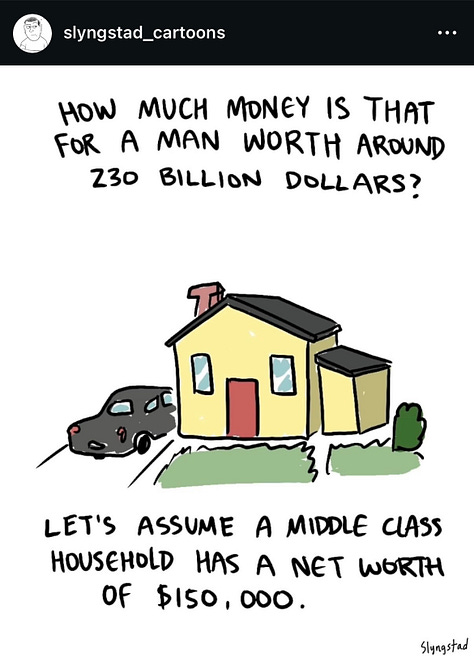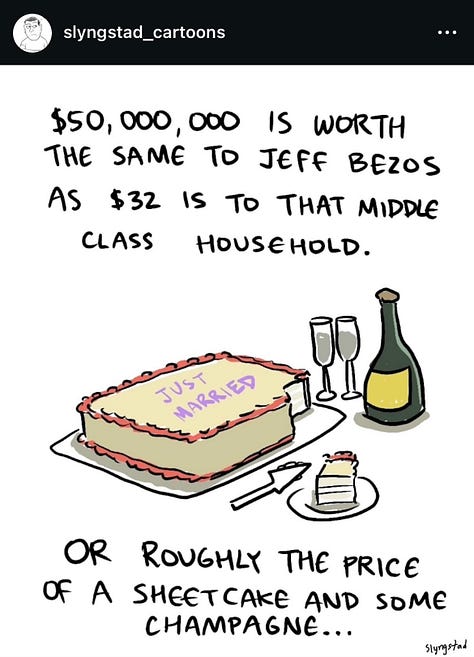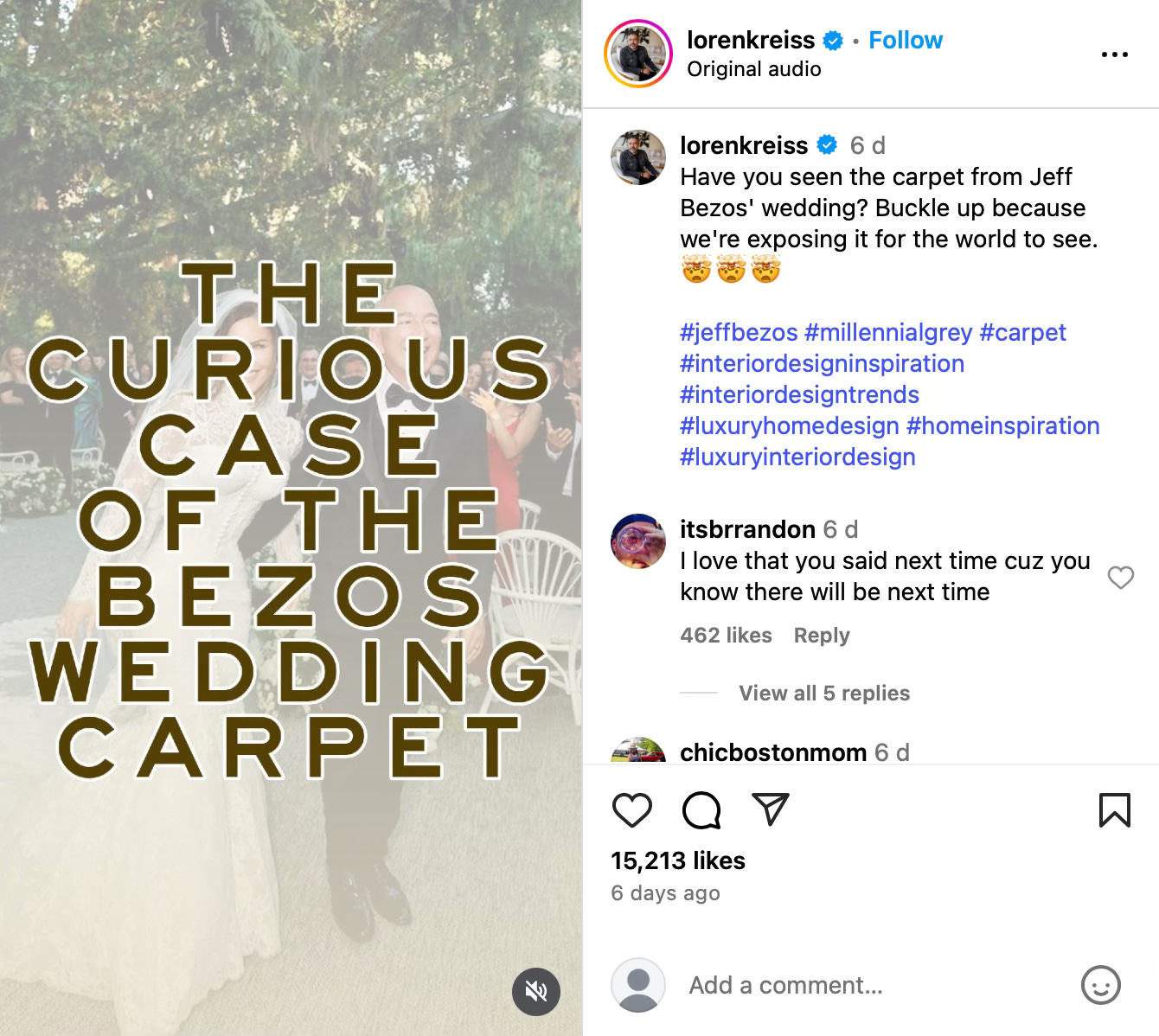The Female Billionaire Club
Part One: Who the world’s richest women really are and how they’re spending, giving, and shaping the future.
When Jeff Bezos tied the knot with Lauren Sánchez last week it was hard to avoid the criticism and the carpet. I particularly enjoyed the calculation that a man worth $230bn spent a mere $50mn on his wedding – equivalent to $32 for an American middle-class household. (Thank you Benjamin Slyngstad for providing the maths and illustration @slyngstad_cartoons.)



Typically, most of the coverage was skewed to the important subject of what the women were wearing. I chose to take a more positive view on what this wedding could represent. Could this be a moment for girl power (not just a girl marrying into power)? And if it was, did this picture of female wealth align with what I know from my research into ultra and high-net-worth individuals?
And so, today’s Affluent Lens covers just that: who are the world’s UHNW females and what power do they hold?
Some girl math:
Just how many female billionaires are there?
Sadly, not that many. Of the 3,323 billionaires globally, only 431 are women—just under 13%. Emerging data predicts that we’ll soon be able to welcome some new female faces to the billionaire club. Why? Three things:
1) Changing cultural attitudes are bringing more women into the boardroom
2) Flexibility of working hours and democratisation of tools (thanks, tech bros) is supporting more new female entrepreneurs
3) The great intergenerational wealth transfer isn’t discriminating by sex
Never ask a billionaire her age – I’ll just tell you.
Billionaires are generally at the greyer end of the age scale (perhaps this explains their obsession with longevity). Wealth X recorded that 48% of billionaires are aged 50-70 and 42% are over 70.
However, whilst only 10% are under 50, females over-index in this group. Consequently, they have a growing share of voice and sphere of influence amongst the ‘new elite’.
And now the interesting part – how did these women make their money?
Whilst we hear a lot about Rihanna, Taylor Swift and the Kardashian-Jenner clan, my own research into this group paints a broader picture.
· Around a quarter inherited their wealth
· About a third are Gen-Xers with their own enterprises
· 10% are high-rolling finance players
· The rest made their fortunes in other industries traditionally dominated by men (technology, healthcare and real estate)
Interestingly, approximately half of my data set identify as entrepreneurs, regardless of their source of wealth.
Could more billionaire women be what the world needs now?
Billionaires make up the top 1% of the 1%, and while only 13% are women, their collective wealth is not a sum to be sniffed at: nearly $2 trillion is increasingly being leveraged for impact, not just accumulation.
The era of the mega fundraiser may be fading, but female philanthropists are more active than ever. Nearly one in five ultra-wealthy women focus their time on non-profit work - four times the rate of their male peers. (A shout out to the ex: MacKenzie Scott who has donated $19.2 billion since 2019.)
These women believe their experience and expertise can deliver more than a signature on a cheque. They're turning to strategic giving vehicles, impact investments, and sustainable funds to drive real change - pioneering a “giving while living” model.
Many are also forming socially minded LLCs, collaborating with fellow benefactors and business leaders to amplify results while distributing risk. These modern structures blend philanthropy, political influence, start-up support and ESG-aligned investing into a single, powerful force.
And when it comes to politics, wealthy women are also holding their own: between 2018–21, ultra-wealthy U.S. women gave an average of $134,100 annually to political causes - more than their male counterparts at $125,000.
So with all the money in the world, what else are they spending on?
In short, dresses, handbags and jewellery. Don’t cancel me, it’s true.
According to Wealth X’ data, UHNW women are much more interested in fashion, theatre, animals, art and health and wellbeing whilst more UHNW men choose to spend time and money on aviation, vehicles, boating, the outdoors and sports.
A longer answer paints a picture of UHNW women leading a soft power movement where luxury consumption is intersecting with identity and investment in nuanced ways.
For the female billionaire, cultural capital is defined by what you collect (art), where you live (real estate), and how you express your identity (fashion & jewellery).
Female billionaires outspend men in fine art acquisition and for those who spend more than $10 million annually, they tend to have a higher share of art works created by women.
Altrata’s World Ultra Wealth Report 2022 found that, if we assumed an equal number of ultra-wealthy men and women (for comparison purposes), then women account for 70% of UHNW owners of luxury watches and jewellery. Demand for high-jewellery and valuable stones is driven by both an emotional and financial investment mandate. Tangible pieces deliver asset security, self-expression and exclusivity.
When it comes to property, female billionaires are 1.5 times more likely than men to own luxury real estate valued at over $10 million, but their approach goes beyond prestige purchases with ambitions to live in and shape places with deep community impact through:
1. Legacy and Stewardship – viewing homes as enduring assets meant to last across generations
2. Place-Based Investment – properties that sit in underinvested areas, channelling capital and attention to emerging markets
3. Community Activation – whether through reviving historic towns, building social infrastructure, or developing eco-resorts, their investments take on a purpose-driven dimension
So let’s go back to where we started. Who are they?
If you’re a marketer trying to build a clearer picture of this elusive and powerful audience then Lauren Sánchez as the new face of the female billionaire isn’t a bad pen portrait.
Though, I’d redraw it a little…
She’d be less pilot and more Philophile.
She’d spend less time in space and more in galleries.
And she’d have a much stronger point of view on her wedding carpet.
If you have any questions or would like to learn more about any of the insights I’ve shared then please comment or get in touch directly.
If your brand or business is trying to reach this UHNW female then come back next Tuesday for Part Two when I’ll be covering more practical tips for engaging these super women. All 432 of them.




